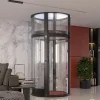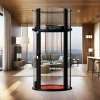Elevators are crucial components of modern buildings, providing essential vertical transportation for passengers and goods. Ensuring their safety and compliance with regulations is paramount to prevent accidents and enhance user experience. This article outlines essential tips for maintaining elevator safety, preventing accidents, and ensuring compliance with safety standards.
1. Regular Maintenance and Inspections
1.1 Scheduled Maintenance:
- Routine Checks: Implement a regular maintenance schedule to ensure elevators operate safely and efficiently. Routine checks should include inspecting mechanical components, electrical systems, and safety features.
- Qualified Technicians: Ensure that maintenance and inspections are conducted by certified professionals who follow industry standards and practices.
1.2 Comprehensive Inspections:
- Safety Components: Inspect critical safety components such as emergency brakes, door sensors, and communication systems to ensure they are functioning correctly.
- Compliance Checks: Verify that elevators meet local and international safety standards and regulations through periodic inspections.
2. Implement Safety Features
2.1 Emergency Communication Systems:
- Alarm Systems: Install reliable alarm systems that alert users and building management in case of emergencies. This includes both audible alarms and visual indicators.
- Intercoms and Communication: Ensure that elevators are equipped with intercom systems or emergency phones for immediate communication with emergency services.
2.2 Safety Sensors and Controls:
- Door Sensors: Equip elevators with door sensors that prevent doors from closing on passengers or objects, reducing the risk of accidents.
- Overload Sensors: Implement overload sensors to prevent the elevator from operating if it exceeds its weight capacity, ensuring safe operation.
3. Educate and Train Users
3.1 User Awareness:
- Safety Guidelines: Provide clear safety guidelines for elevator users, including instructions on safe entry and exit, and the proper use of elevator buttons and controls.
- Emergency Procedures: Educate users on emergency procedures, including how to use emergency communication systems and what to do if an elevator becomes stuck.
3.2 Staff Training:
- Training Programs: Conduct regular training programs for building staff on elevator safety protocols, emergency response procedures, and basic troubleshooting.
- Safety Drills: Organize safety drills to ensure that staff are prepared to handle emergencies effectively and can assist users in case of a malfunction.
4. Ensure Accessibility and Compliance
4.1 ADA Compliance:
- Accessibility Features: Ensure that elevators comply with the Americans with Disabilities Act (ADA) or other relevant accessibility standards. This includes features like braille controls, audio announcements, and spacious cabins.
- Maintenance of Accessibility Features: Regularly check and maintain accessibility features to ensure they remain functional and meet regulatory requirements.
4.2 Code Compliance:
- Local Regulations: Stay informed about local building codes and safety regulations that apply to elevators. Ensure that all installations and modifications comply with these codes.
- Documentation: Keep detailed records of maintenance, inspections, and compliance checks to demonstrate adherence to safety regulations and address any issues promptly.
5. Address Common Safety Issues
5.1 Preventive Measures:
- Regular Cleaning: Keep elevator interiors clean and free of obstructions to prevent accidents caused by slips or trips.
- Door Mechanisms: Regularly inspect and service door mechanisms to prevent malfunctions or entrapment issues.
5.2 Quick Response:
- Immediate Repairs: Address any reported issues or malfunctions promptly to prevent potential accidents. Ensure that repairs are conducted by qualified professionals.
- User Reporting: Encourage users to report any safety concerns or irregularities immediately to ensure timely resolution.
6. Promote Safety Culture
6.1 Safety Policies:
- Implement Policies: Develop and enforce safety policies related to elevator use and maintenance within the building. Ensure that all staff and users are aware of these policies.
- Continuous Improvement: Foster a culture of continuous improvement in safety practices by regularly reviewing and updating safety procedures based on feedback and industry advancements.
6.2 Building Management:
- Proactive Approach: Take a proactive approach to safety by regularly reviewing elevator performance, addressing potential risks, and implementing improvements based on safety assessments.
- User Engagement: Engage with building occupants to promote safety awareness and encourage responsible use of elevators.
Conclusion
Elevator safety is a critical aspect of building management, requiring diligent maintenance, effective safety features, and compliance with regulations. By implementing regular maintenance schedules, installing essential safety components, educating users, and ensuring compliance with accessibility and safety codes, building owners and managers can significantly reduce the risk of accidents and enhance overall safety. Promoting a safety-conscious culture and addressing common issues promptly will help ensure that elevators remain a reliable and secure mode of transportation for all users.








